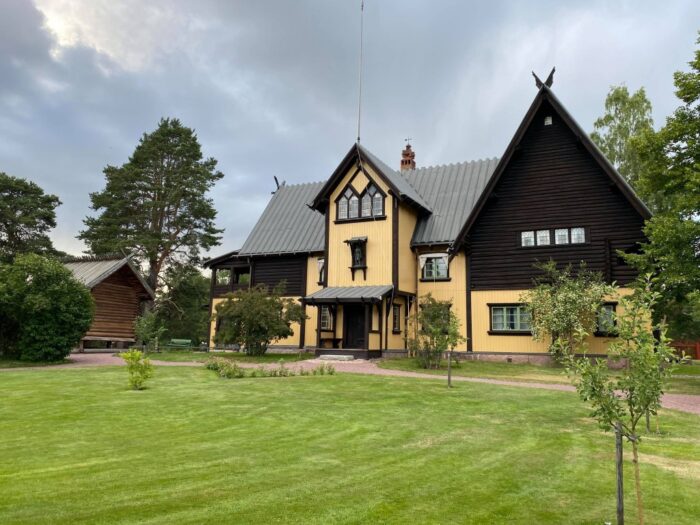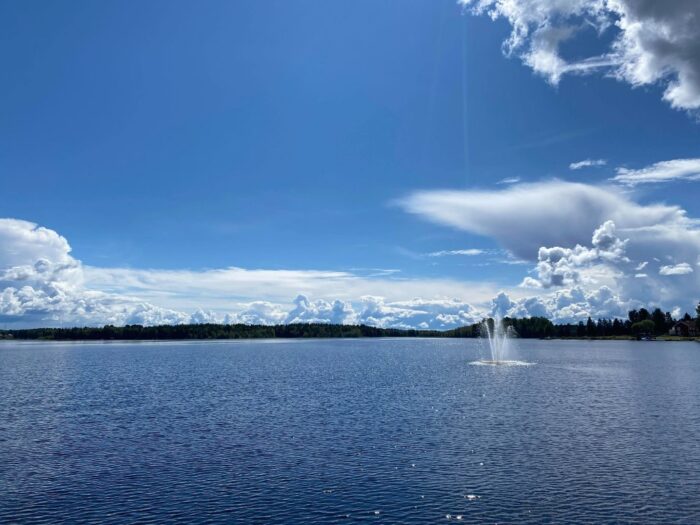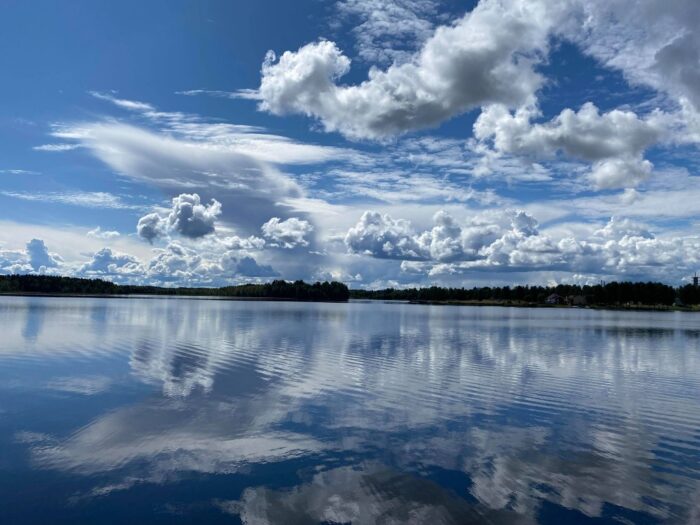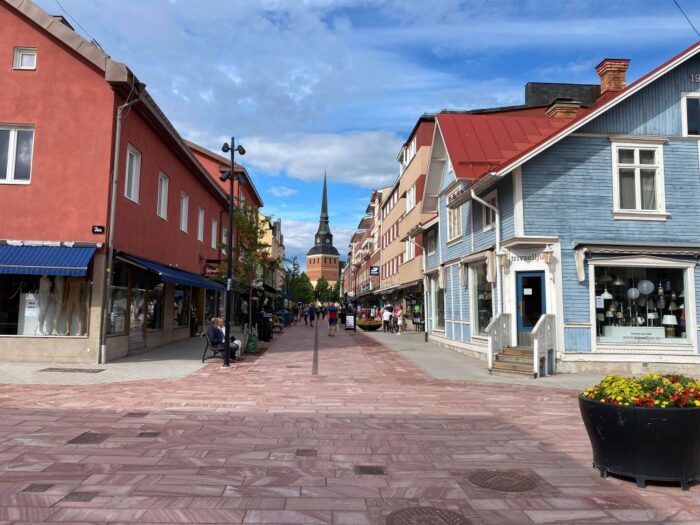Mora has played an important part in the establishment of what is today Sweden and there are many signs around the town of its long history. A name that is hard to miss is Vasa. He was the first Swedish king after the independence from the union with Denmark and Norway in the 16th century.
Mora has a population of around 12.800 inhabitants and it is the home of the annual 90-kilometer cross-country ski race Vasaloppet, yet another reminder of its proud past.





A Short History
The first known mention of Mora dates back to the year 1325. It is thought that the Mora Parish has an even longer history, maybe even back to the 13th century.
The first major known event in Mora’s history occurred in 1520. This is when the saga about Gustav Vasa unfolds in Mora. Sweden was at the moment in a personal union with Denmark and Norway known as the Kalmar Union. The union was governed by Copenhagen and the Swedish liberation struggle was ongoing but still weak. Gustav Vasa had recently escaped captivity in Denmark and was heading to the province of Dalarna to hide from the Danish soldiers looking for him. At the same time, he attempted to find an audience for his ideas and people willing to join the struggle. After a weak outcome in Rättvik, he continued to Mora and struggled once more to get the needed support. The dissatisfied outcome resulted in Gustav Vasa leaving Mora on foot towards the Norwegian border.
The events that took place in Mora the days after the departure of Gustav Vasa would eventually change Swedish history. Danish soldiers arrived looking for the fugitive and the news about the blood bath in Stockholm reached the inhabitants of the town. The opinion changed and they decided to find Gustav and bring him back to Mora. Their fastest ski runners caught up with Gustav Vasa in Sälen and this is the start of what is since 1922 the cross-country skiing competition Vasaloppet. Well, the support was also an important part of the Swedish independence in 1523.
The hardships of the 18th century would provide new opportunities for Mora. The harvests were small and many were forced to migrate, mostly to Stockholm and southern Sweden. What happened afterward changed the area. The migrants returned with new knowledge and developed both farming as well as other industries. The most famous of these developments is the clock production which began at the end of the 18th century. The clock manufacturing later led to sewing machines in the 19th century and later other metal works, such as knives.





Things to Do and See
In and around Mora you can meet royalty in the shape of Gustav Vasa, an impressive skier nicknamed “Mora-Nisse”, the recognized artist Anders Zorn, and of course, the Christmas front figure, Santa Claus. We will leave it up to you to decide whose story is closest to the truth and most realistic.
And once you’re done with history and sagas, there is also nature around the corner. Especially Lake Siljan can offer some great days in case of good weather.
Vasa Monument
This is a memorial of Gustav Vasa that can be found at the address Monumentsvägen 20. The monument was created in 1860, 300 years after the death of the king. The chosen location is one of the spots where Gustav was hiding from the Danes.
Statue of Gustav Vasa
There is also a statue of the former king. It was created by the local artist Anders Zorn and raised at the hill where Gustav Vasa is supposed to have spoken to the people of Mora. The statue dates back to 1903 and has the year 1520 inscribed.
Ångloket – The Steam Engine
Along Mora’s waterfront, you can find an old steam engine. It was constructed in Motala in 1916 and was in use in Dalarna from 1948 to 1960.
Zorn Museum
The Zorn museum is located in the center of the town and is displaying the works by the local artist Anders Zorn (1860-1920). Anders Zorn is considered to be one of Sweden’s foremost artists and was born in Mora in 1860.
Zorngården
Zorngården was the home of Anders and Emma Zorn and is today open for guided tours. The house dates back to 1886 and the small original timber cottage was extended several times until 1910, when it received its current appearance.
Vasaloppet
For those of us who don’t have the technique or stamina to complete the real cross-country skiing competition, there are still parts of the route to explore. The skiing distance is 90 kilometers. The race starts in Sälen and the finish is in the center of Mora. In Mora, you have several year-round sights connected with the race. The most obvious one is the finish line itself. There is also the Vasalopp Museum opened in 1994, where you can learn more about “Mora-Nisse” and the race. “Mora-Nisse”, or Nils Karlsson as was his name, was a Swedish cross-country skier. Born in 1917 in a village outside of Mora he eventually won Vasaloppet 9 out of 10 times between the years 1943 and 1953, just missing 1944 (2nd) 1952 (not participating). He also won an Olympic gold medal in the 50 km race in Sankt Moritz.
Mora Church
The oldest part of the church dates back to the 13th century. It has been extended several times over the centuries and did not receive its current form until 1965 after a larger restoration.
Santaworld
Swedes and Finns do not agree on the hometown of Santa Claus, at least not more than agreeing that it is not the North Pole. The Finns consider it to be Rovaniemi, while Swedes would say, Mora. So outside of Mora, you can find Santaworld, a theme park that opened in 1984.
Mora IK and Smidjegrav Arena
Mora IK is an ice hockey club founded in 1935. The team is currently playing in Hockeyallsvenskan (the Swedish second-tier league). They have, however, played 27 seasons in the top league (Elitserien/SHL), the last time was as recently as the season 2018-19. Some of the more internationally famous players that have played for the team are Marcel and Marián Hossa as well as Rastislav Pavlikovský and Shawn Horcoff. These players played here during the NHL lockout season 2004-05. The second NHL Lockout 2012-13 saw Anže Kopitar in the Mora jersey.
Mora IK plays their home games at Smidjegrav Arena, previously known as Mora Ishall, FM Mattsson Arena, and Jalas Arena. It finished construction in 1967 and has after a renovation in 2004 a capacity of 4.500 spectators for an ice hockey game. This makes it the 25th largest ice hockey arena in Sweden.
Winter Sports
A snowy visit? Winter sports are big in Mora and there are many options when heading outdoors. Tour skating (long-distance ice skating) on lake Siljan is one possibility, there are prepared routes during the winter months. Then there is of course cross-country skiing. Vasaloppet might not be for everyone, but there are many more options in and around Mora with prepared tracks. Also, alpine skiing is available at Gesundaberget and Gopshusbacken. Gesundaberget has 5 lifts and 12 slopes, with a maximum altitude difference of 270 meters. Gopshusbacken is smaller and has 2 lifts and 7 slopes with an altitude difference of 180 meters.
Summer Outdoor Activities
For the ones of us that prefer visiting new places when the ground is not frozen, there are several activities available in Mora also during the summer. Fishing is available in several lakes and rivers, such as the river Österdalälven. Remember that most of these require a permit. Bike routes are available in many places and for the most adventurous ones, there is the possibility to bike around Lake Orsa, which is around 40 kilometers. A multi-day tour around Lake Siljan might also be tempting. Both Lake Orsa and Lake Siljan also offer several beaches for swimming. In regards to hiking, the possibilities are endless, with scenic routes or just walks through the nature reserves of the area. There are also the more known hiking trails, Vasaloppsleden which is 90 kilometers, and Siljanleden which is 340 kilometers.





How to get to Mora
- Flights: The closest airport is Mora–Siljan Airport located 7 kilometers away. It connects the area with the Stockholm-Arlanda Airport (ARN) for connections around the globe.
- Car: Mora is located along the E45 between Orsa and Malung as well as along road 70 between Älvdalen and Rättvik.
- Train: There is regional and National trains connecting Mora with Borlänge, Mjölby and Stockholm. The station is also a part of Inlandsbanan with trains to Östersund.
- Bus: There are regional buses connecting Mora with the surrounding area as well as national services connecting with other parts of Sweden.
The driving distance from 5 major Swedish cities, according to Google Maps:
- Stockholm – 308 kilometers (3 h 43 min)
- Gothenburg – 474 kilometers (5 h 49 min)
- Malmö – 692 kilometers (8 h 9 min)
- Linköping – 375 kilometers (4 h 47 min)
- Kiruna – 1117 kilometers (13 h 46 min)
Find out more about other destinations in Sweden by visiting our page Exploring Sweden







looks beautiful
Mora looks like a beautiful place, judging from your excellent photos.
I grew up living on a lake in western Washington State, US. There’s a private park on that lake called Vasa Park Resort offering camping spots, boat ramp, swimming, picnic tables and a dance/banquet hall. Visited often as a child. I always knew it was created and operated by Swedes, but now I know the significance of the name Vasa.
Always a pleasure to provide some additional insight. Vasa really has a strong connection with Swedish history and also with traditions and culture. I can only assume that the name is to be found in several places, especially in America. 🙂
Sweden! I did get to visit your beautiful country and enjoyed it. I didn’t get to Mora so I very much appreciated the tour you gave me of the town and its history. As a history buff, this post was right up my alley. Thank you for choosing to follow my blog, I am honoured and shall watch yours to see what you are up to.